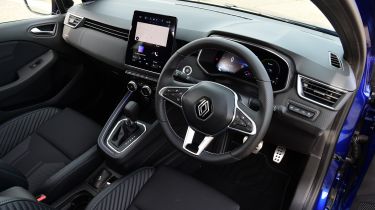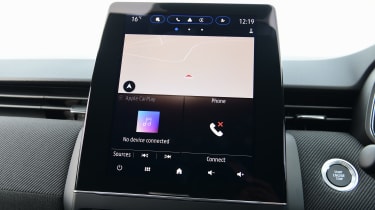Renault Clio - Interior, design and technology
The Renault Clio’s interior is simple and logical, and a mid-life facelift has made it the sharpest-looking supermini on the market

For the Mk5 Clio’s mid-life facelift, Renault decided to ditch the smooth, subtle front end it originally had for a much sharper and certainly more distinctive look that takes its inspiration from Renault’s new Austral family SUV, Rafale coupe-SUV and all-electric Megane E-Tech hatchback.
The updated Clio’s LED headlights are slimmer than before and are flanked by a new and very dramatic lighting signature. The rear end has also received a bit of a nip and tuck, with new tail-lights and aerodynamic elements in the rear bumper to emphasise the car’s width. There’s also fresh colour options and new wheel designs stretching up to 17 inches, including the rather fetching diamond-cut rims on the new range-topping Esprit Alpine trim.
Compared to its predecessor, the Mk5 Clio made some big steps forward in terms of build quality, materials used and, perhaps most importantly in today’s market, infotainment. It was already one of the best interiors in the supermini class, so we’re not surprised Renault didn’t change much as part of the car’s facelift. That said, a few more tweaks wouldn’t have gone amiss, as the Clio’s cabin lacks the wow-factor you get from the Austral or Megane, and the Google tech featured in both.
Used - available now
On the plus side, the Clio’s dashboard continues to prioritise ergonomics over style, as it still uses physical dials and piano-style keys, plus all the major controls are raised so they’re easy to reach when you’re driving. A touchscreen infotainment display – available in two sizes – sits proudly in the centre, canted towards the driver, and is also easily reached and operated.
There’s a lot of plastic on show, but the majority of it feels of good quality and it’s all well put-together. Plus, you won’t find any cowhide inside the Clio now, with certain models instead using either bio-sourced or partially recycled materials.
Iconic and SE Edition trims have been discontinued, with Evolution and Techno specifications taking their place in the Clio line-up behind the new Esprit Alpine trim which essentially replaces R.S. Line, while E-Tech Engineered has also been axed.
Entry-level cars are well-equipped, with 16-inch alloy wheels, LED headlights, lane keeping assist and rear parking sensors all included as standard. Inside you’ll find a seven-inch digital driver’s display and central touchscreen of the same size.
Upgrading to a Techno version brings bigger 17-inch alloys, body-coloured ‘F1 Blade’, honeycomb lower grille, chrome exterior trim, a rear-view camera, ‘biobased’ upholstery and a wireless smartphone charging pad. Techno models also add three driving modes and an electric parking brake with auto-hold function for stop-start traffic.
Esprit Alpine trim builds on previous specifications by adding a contrasting coloured ‘F1 Blade’, 17-inch diamond-cut wheels, Alpine-branded sports seats, aluminium pedals, a perforated steering wheel and French tricolour details dotted around the cabin. Top-spec cars also feature adaptive cruise control, blind spot warning, a 9.3-inch central touchscreen and a 10-inch digital driver’s display.
Sat-nav, stereo and infotainment
Every Renault Clio comes with wireless Android Auto and Apple CarPlay connectivity, sat-nav, a digital driver’s display and central touchscreen. But as we mentioned, lower-spec cars get two seven-inch displays, meanwhile, top-of-the-range models feature a 10-inch instrument panel and 9.3-inch touchscreen.
The Clio doesn’t benefit from Renault’s magnificent Google-powered OpenR Link infotainment software, like you’ll find in the Megane E-Tech and Austral. Instead, it sticks with Renault’s older ‘easylink’ setup that’s still easy enough to navigate, and the home page – split into three main functions – is reminiscent of the systems fitted to more premium offerings. But the Clio’s system can be quite sluggish at times, and simply isn’t as intuitive as the firm’s latest software.
The lack of a physical volume knob means that it’s not immediately obvious how to adjust audio settings on the move compared with other superminis, but the Clio does feature extra controls mounted behind the wheel on the steering column. They’re largely unchanged from Renaults built as far back as 20 years ago, and with good reason – the setup is very simple and easy-to-use.














